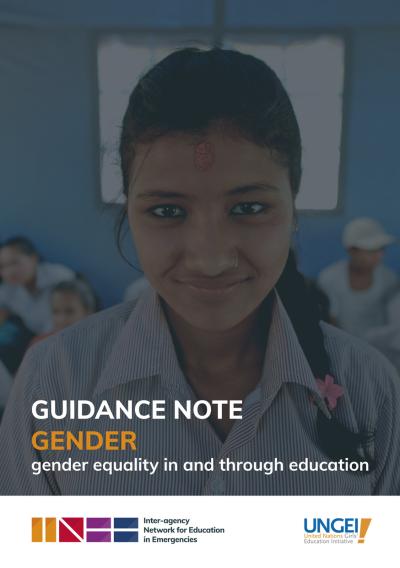Género
A vivência e o impacto de uma situações de emergência é profundamente diferente entre meninas e mulheres, e meninos e homens. As meninas e as mulheres enfrentam diferentes ameaças e riscos e têm diferentes mecanismos de resposta e enfrentamento para lidar com os efeitos das situações de crise e deslocação forçada.
As situações de emergência podem resultar na perda de meios de subsistência e na alteração dos papéis sociais. As dinâmicas de poder dentro das famílias, comunidades e sociedades estão frequentemente em mudança e podem alterar o estatuto das mulheres e dos homens. Nesses contextos, as necessidades educativas mudam e muitas vezes surgem barreiras diferentes para rapazes e raparigas, com as raparigas geralmente experimentando maiores desvantagens. Quatro dos cinco países com as maiores disparidades de género na educação são afetados por conflitos, e as raparigas em contextos de crise são duas vezes e meia mais propensas a abandonarem a escola primária e 90% mais propensas a abandonarem a escola secundária do que as suas pares em contextos mais estáveis.
As raparigas tendem a enfrentar múltiplas ameaças no acesso à educação segura e de qualidade. Estas podem estar diretamente ligadas a uma situação de emergência, tais como ataques direcionados a escolas de raparigas e violência baseada no género e deslocações forçadas relacionadas com a escola. As ameaças também podem estar indiretamente ligadas, mas exacerbadas por uma situação de emergência, tais como o casamento precoce, menor disponibilidade de serviços de saúde sexual e reprodutiva, maior desvantagem das raparigas com deficiência e aumento dos custos das oportunidades educativas. À medida que os custos aumentam para enviar as crianças à escola em situações frágeis, as adolescentes ficam particularmente em desvantagem em relação aos rapazes, sendo que a educação muitas vezes não é considerada um investimento. Homens e rapazes também estão expostos a várias ameaças que minam as suas oportunidades educativas. Os conflitos podem ter um impacto maior na educação dos rapazes em certos contextos em que é mais provável que eles sejam recrutados para as forças armadas ou pressionados a aceitar empregos remunerados.
As mudanças nos papéis e relações de género observadas após as situações de crise apresentam a oportunidade de aproveitar essas dinâmicas e estabelecer novos precedentes para a igualdade de género. De facto, a investigação global demonstra que o conflito é menos provável em contextos onde há paridade de género no que respeita à média de anos de escolaridade. Além disso, práticas promissoras emergentes mostram que, quando a educação de boa qualidade, relevante, sensível às questões de conflito e de género está disponível de forma equitativa, pode quebrar ciclos de conflito e violência, redefinir normas de género e promover a tolerância e a reconciliação. Os compromissos globais refletem a crescente priorização da igualdade de género, bem como da educação em contextos de conflito e crise por meio dos ODS, do Marco de Ação para a Educação 2030, da Cimeira Humanitária Mundial e da Declaração Charlevoix de 2018 sobre Educação de Qualidade para Meninas, Adolescentes e Mulheres em Países em Desenvolvimento.

É fundamental um maior investimento em práticas promissoras emergentes em estratégias específicas para implementar a EeE sensível às questões de género, no sentido de permitir que as crianças e as e os jovens contribuam para a promoção de sociedades pacíficas, equitativas e prósperas em termos das questões de género.
Mensagens-chave:
- É urgentemente necessário um maior investimento na educação das raparigas em contextos afetados por conflitos no sentido de alcançar os ODS.
- Quando a educação de boa qualidade relevante, sensível às questões de conflito e de género está disponível de forma equitativa pode ser transformadora e promover a paz e a estabilidade.
- As crianças em países afetados por conflitos estão particularmente expostas ao risco da violência baseada no género relacionada com a escola.
- A educação de qualidade pode permitir às raparigas adquirirem o conhecimento necessário para apoiarem a recuperação, o crescimento económico, a paz e a estabilidade de um país.
- O conflito é menos provável em contextos onde há paridade de género em termos de anos médios de escolaridade.
- Quatro dos cinco países com as maiores disparidades de género na educação são afetados por conflitos.
- Nove dos dez países nos quais se verificam os níveis mais baixos de igualdade de género, relativamente à conclusão do processo de escolaridade, no mundo correspondem a estados frágeis.
Esta coleção foi desenvolvida com o apoio de Emilie Rees Smith, Especialista em Género, Educação e Conflito da Iniciativa de Educação de Raparigas das Nações Unidas.




